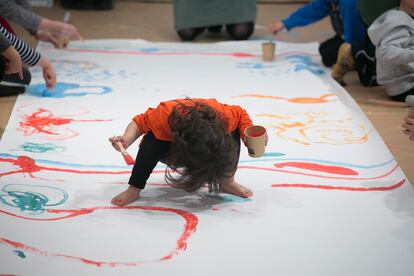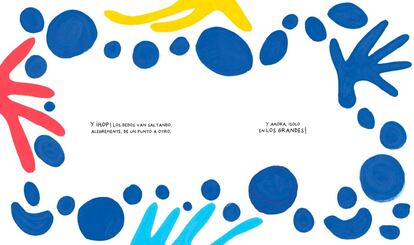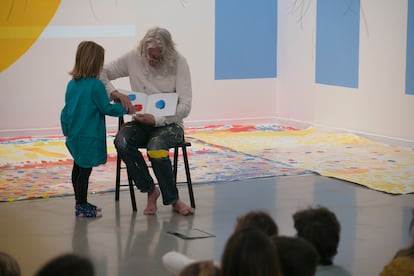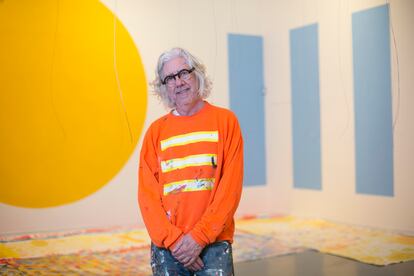White hair, jeans full of paint, glasses “à la Le Corbusier”. “I’m funny, but not nice, I like the distance they create,” says Hervé Tullet (Avranches, 66 years old), artist, rockstar of children’s literature and a charming guy.
His books, sold by millions around the world, are an experience. In Colors, Oh!, The dance of the hands, Shall we play? or the iconic a book (four years on the best-seller list of The New York Timesin Spain all edited by Kókinos) there are no characters or story, only spots and interpellation (touch the yellow circle, blow, move your hand, say oh!). With Tullet, the magic happens when you turn the page.
This weekend he visited the Abrapalabra festival at La Casa Encendida in Madrid, where tickets to interact with him sold out in an hour and where his work will remain for several weeks. Their workshops are a joy of guttural noises, movement and creativity. Connect immediately with your audience. And he doesn’t remember anything from when he was a child. “My childhood is a desert, I didn’t understand anything, it was as if I didn’t exist, I only remember that I was bored,” he says. To fill in the gaps, next year he will publish a “creative biography” — “a construct, an explanation perhaps” — in which he elaborates on how he turned “that boredom into a philosophy.” “You have to be bored to have ideas,” he says.
Ask. What were your parents like?
Answer. Very nice people. Very regulated. My father had a grocery store, my mother helped him… She was very traumatized by the war, she always had bombs in her head. And that led to a certain silence, a lack of communication… Maybe that’s why the first thing I tried to do with my children was give them memories.
P. Did you develop your childhood connection with them?
R. Yes, my children were a huge discovery. I was surprised at how close I felt to them. I really enjoyed the three of them as children. I started making children’s books when the first one, Leo, who is now my manager.
P. From that first book, How Dad Met Mom (How Dad Met Mom, 1994), he has said that it already contained everything.
R. The narration occurs through the punched holes. ideas exist between the pages, in that process of turning the page. There was also provocation, sex and violence, so it was not typically childish, another feature of my work. And the points and the voice that challenges the reader to interact already appeared. Also, it is a fact, it is very poorly drawn. Not knowing how to draw has made me more creative because I had to find my own solution to transmit ideas, avoiding drawing, without elephants or princesses… It was fortunate, I became more and more precise and created my own vocabulary of points, lines, stains, wrinkles or holes with which I can express my ideas. In reality, you always make the same book. In that sense my bible is Don’t confuse (Prize at the 1999 Bologna Children’s Book Fair, inaugurated by Opposites, later imitated ad nauseum).
P. In addition to 80 books, he publishes games, holds workshops, exhibitions, performances. What are you?
R. I’m discovering it while I do things. I was a publicist, illustrator, author of children’s books, now I say that I am an artist, but maybe I am also an actor, because I am doing theater…
P. What do you think of the label ‘children’s literature’?
R. I find it narrow. I don’t look for the shelves marked “children’s books” when I go to a bookstore. I am more interested in the dialogue between adults and children. I’m more interested in myself. That’s what guides me. But the gaze of children is fascinating, accepting of everything, and offers a wonderful way to push your limits.
R. Is there an artist in every child?
P. No. But I think that many artists steal the child’s spirit. Especially in the 20th century: Miró, Calder, I love them, huh. Dubuffet even collected children’s drawings.
P. His style is also childish.
R. Yes, but it’s a little different, I don’t steal, I give. In the workshops I give space, music, color… I give instructions, but the children can push their own limits and have a good time.

P. His interest in art arose with the surrealists.
R. They interest me less now, but as a teenager they opened my mind. Surrealism was a huge explosion of creativity. He discovered a freedom and energy in me that I was unaware of.
P. Is that why you wanted to study Fine Arts?
R. I have never, not even today, wanted to do anything. I just follow the line. Everything comes to me by chance. I don’t make plans. I don’t think. I just follow the line. I don’t know where it takes me, I try to direct it a little, but little. I’ve always been like that.
P. And where is the craziest place the line has taken you?
R. In a radio interview I said that my work was theatrical. They called me to offer me a theater and I ended up doing, last year in Paris, a show of lights, music, movement and improvisation. In New York I was asked to do a mural in a school and I ended up on a scaffold 30 meters away, scared to death.
P. What type of art are you interested in now?
R. Of all kinds, for example, I love dance. the book The dance of the hands It occurred to me at a MoMa exhibition when I lived in New York about the sixties experimental group Judson Dance Theater.

P. Any tips for visiting a museum with a child?
R. In general, when dealing with a child, be yourself. Express yourself like an adult. Say things like “I don’t know” or “I’m bored.” Sometimes with my children I read bad books and I read them wrong on purpose just to say “how horrible!”
P. And what did you enjoy reading to them?
R. Many French classics, Philippe Corentin, humor books, poetry… reading with them was a real pleasure.
P. What did you learn as an advertising art director in the 1980s?
R. I discovered the ideas. It was a wonderful time for advertising. Everyone was looking for the craziest ideas. But it was hard work, very competitive. Computers were starting and I didn’t see myself growing old there. Then I was so used to working for a client that it took me several years to find the confidence to work for myself.

P. What is the key to your success?
R. I am generous. I work for myself, but I also broadcast a lot. I deal a lot with people, on social networks, in exhibitions, in workshops… And I am in contact with educators, I feel that I work for teachers and librarians not for bookstores. They are the ones who really know children’s books, parents don’t have time or don’t care if a book is recent. With teachers and librarians you can build a relationship. And they always need new books! I avoid literary fairs, I don’t sign autographs. What I’m looking for is to generate experiences.
P. You work closely with the creative director and editor, what is your process like?
R. I have always had a very close relationship, great friendships with these figures. They are like translators. I have an idea in mind but I’m not sure if it is understood. It is still new, rare, very fragile. I develop and structure it in a notebook, which is now a public space, open to my editor, my art director (with whom I have worked since my first book) and my son Leo. If they catch it, the idea is no longer so fragile. And together we look for the best way to turn it into something communicable. A text that captivates the reader from the beginning and explains how to get to the end, but in its own way, because my books require a lot of creativity on the part of the reader. To read me, you have to play with me, play with your child. They require complicity.
P. Something that makes his books very universal is that they have no morals.
R. It’s what I liked least about children’s books when I started. I don’t know if they’re still the same now, but they were such nerdy messages: the world is wonderful, be good, rainbows…
P. Although they do not express it, their books do have an underlying message.
R. Of course they have it. My only message is: discover by playing.
P. Now children discover the world through screens.
R. Already. I broke down when Trump won. The current ignorance is terrible and that ignorance is legitimized through the screens. And for good reason: culture has become inaccessible and there is this channel to rebel, to say “fuck you.” People have no hope, nor do they know anything, nor do they want to know. And when nothing matters, “fuck you” triumphs. At the same time, for me, social media is fantastic, I get tons of good messages. I interact with my followers, with words, drawings, projects. It is a community with a life of its own, because I am not a guru. But it’s exciting to bring so many people into contact through my work. Because I play a lot and I don’t have a clear message, but it is serious work, what I say is important.

